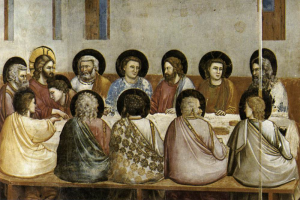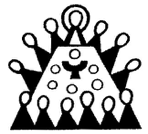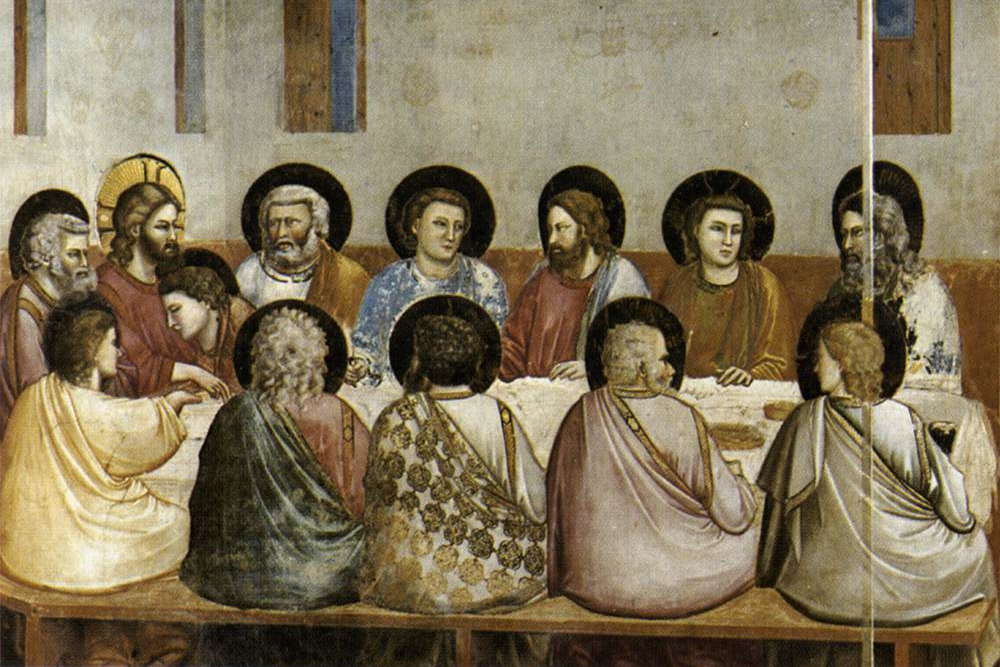 At the heart of our faith is the Paschal mystery: the Passion, death, resurrection, and ascension of Jesus Christ. All of salvation history leads up to and goes forth from these saving events. We call this “Holy Week” because Jesus’ public ministry culminates with His suffering, death, and resurrection.
At the heart of our faith is the Paschal mystery: the Passion, death, resurrection, and ascension of Jesus Christ. All of salvation history leads up to and goes forth from these saving events. We call this “Holy Week” because Jesus’ public ministry culminates with His suffering, death, and resurrection.
What follows is a brief description of each day of Holy Week. I publish it every year, often adding a few details. I hope you will print out this flyer (Walking with Jesus in Holy Week) and read it each day this week. Walk with Jesus prayerfully in His most difficult yet most glorious week.
Some scholars of Scripture scoff at the idea that we can construct a day-by-day journal of Jesus’ last week. There are historical gaps as well as things in the different accounts that don’t agree perfectly. Further, St. John posits a slightly different timeframe (shifted by one day) for the Last Supper relative to Passover. The following sequence follows the timing of the synoptic (Matthew, Mark, and Luke) accounts. Despite certain scholarly doubts, the accounts really do add up fairly well if one uses a little imagination and views the differences not as factual discrepancies but rather only as variations in the level of detail.
So read this chronology as a likely, but not certain, outline of Jesus’ last week. It is a great blessing to consider the Lord’s last week and to walk with Him.
Plan to attend some or all of the special liturgies of Palm Sunday, Holy Thursday, Good Friday, and Holy Saturday at your parish. By celebrating them in community, we make them present today and we learn again, in a new way, the reality of our risen Lord, alive in our midst.
 PALM SUNDAY – Our celebration of Holy Week commences as we remember and make present the triumphant entrance of Jesus into Jerusalem to begin His final week and initiate His Passion. All four of the Gospels recount that Sunday morning so long ago. As you receive your palms, ponder being a part of that vast crowd. How will you journey with Jesus this week? Let the palms remind you to praise Him with your prayerful presence during the sacred Triduum (literally, three days). According to Mark 11:11, Jesus returned that evening to Bethany, a suburb of Jerusalem. Perhaps He stayed with his friends Martha, Mary, and Lazarus. Pray with Jesus this evening and think about how He contemplated the difficult days ahead of Him.
PALM SUNDAY – Our celebration of Holy Week commences as we remember and make present the triumphant entrance of Jesus into Jerusalem to begin His final week and initiate His Passion. All four of the Gospels recount that Sunday morning so long ago. As you receive your palms, ponder being a part of that vast crowd. How will you journey with Jesus this week? Let the palms remind you to praise Him with your prayerful presence during the sacred Triduum (literally, three days). According to Mark 11:11, Jesus returned that evening to Bethany, a suburb of Jerusalem. Perhaps He stayed with his friends Martha, Mary, and Lazarus. Pray with Jesus this evening and think about how He contemplated the difficult days ahead of Him.
Monday of Holy Week – According to Matthew 21, Mark 11, and Luke 19, Jesus returned to Jerusalem on this day and, seeing shameful practices occurring in the Temple area, cleansed it. The Gospel of John also records that Jesus rebuked the unbelief of the crowds. Pray with Jesus and ponder His zealous desire to purify us.
Tuesday of Holy Week – According to Matthew, Mark, and Luke, Jesus again returned to Jerusalem, where He was confronted by the Temple leaders for His actions on the previous day; they questioned His authority. Jesus also taught extensively, using parables as well as other forms. There was the parable of the vineyard (cf Mt 21:33-46), the parable of the wedding banquet (cf Mt. 22:1), the teaching on paying taxes (cf Mt 22:15), and the rebuke of the Sadducees who denied the resurrection (cf Mt. 22:23). There was also the fearful prophecy about the destruction of Jerusalem if the inhabitants did not come to faith in Him: Jesus warned that not one stone would be left on another (cf Mt 24). Continue to pray with Jesus and listen carefully to His final teachings.
Wednesday of Holy Week – Traditionally, this day was called “Spy Wednesday,” for it was on this day that Judas conspired to hand Jesus over. For this, he was paid thirty pieces of silver (cf Mt. 26:14). Jesus likely spent the day in Bethany. In the evening, Mary of Bethany anointed Jesus with costly perfumed oil. When Judas objected, Jesus rebuked him, saying that Mary had anointed Him for His burial (cf Mt 26:6). The wicked are plotting against Jesus; are you praying?
 HOLY THURSDAY – This marks the beginning of the sacred Triduum. Early in the day, Jesus gave instructions to the disciples on how to prepare for this most holy meal, which would be His last supper. Throughout the day they made these preparations (cf Mt 26:17). In the Mass of the Lord’s Supper we remember and make present the last meal that Jesus shared with His disciples. We place ourselves in the upper room with Jesus and the apostles and do what they did. Through the ritual of washing the feet (Jn 13:1) of twelve parishioners, we unite in service to one another. Through our celebration of this very first Mass and Holy Eucharist (Mt 26:26), we unite ourselves to Jesus and receive His Body and Blood as if for the first time. We especially thank God for His gift of the ministerial priesthood. After the Last Supper (the very first Mass), Jesus and the apostles made a short journey across the Kidron Valley to the Garden of Gethsemane, where He asked them to pray while He experienced His agony (cf Mt 26:30). During today’s Mass we process with Jesus in the Blessed Sacrament to a garden (the altar of repose) that has been prepared. The liturgy ends in silence. It is an ancient custom to spend an hour before the reposed Blessed Sacrament on this night. As we pray, we are with Jesus in the Garden as He goes through His agony. Many parish churches remain open until nearly midnight because it was at this time that Jesus was betrayed by Judas, was arrested, and was taken to the house of the high priest (cf Mt. 26:47).
HOLY THURSDAY – This marks the beginning of the sacred Triduum. Early in the day, Jesus gave instructions to the disciples on how to prepare for this most holy meal, which would be His last supper. Throughout the day they made these preparations (cf Mt 26:17). In the Mass of the Lord’s Supper we remember and make present the last meal that Jesus shared with His disciples. We place ourselves in the upper room with Jesus and the apostles and do what they did. Through the ritual of washing the feet (Jn 13:1) of twelve parishioners, we unite in service to one another. Through our celebration of this very first Mass and Holy Eucharist (Mt 26:26), we unite ourselves to Jesus and receive His Body and Blood as if for the first time. We especially thank God for His gift of the ministerial priesthood. After the Last Supper (the very first Mass), Jesus and the apostles made a short journey across the Kidron Valley to the Garden of Gethsemane, where He asked them to pray while He experienced His agony (cf Mt 26:30). During today’s Mass we process with Jesus in the Blessed Sacrament to a garden (the altar of repose) that has been prepared. The liturgy ends in silence. It is an ancient custom to spend an hour before the reposed Blessed Sacrament on this night. As we pray, we are with Jesus in the Garden as He goes through His agony. Many parish churches remain open until nearly midnight because it was at this time that Jesus was betrayed by Judas, was arrested, and was taken to the house of the high priest (cf Mt. 26:47).
 GOOD FRIDAY – All through the previous night, Jesus had been locked in the dungeon of the high priest’s house. Early in the morning He was brought before Pontius Pilate, who transferred the case to Herod. Herod promptly sent Jesus back to Pilate. Sometime in the middle of the morning, Pilate bowed to the pressure of the Temple leadership and the crowds and condemned Jesus to a horrible death by crucifixion. Late in the morning, Jesus was taken by soldiers through the city and up the hillside of Golgotha. By noon, He had been nailed to the cross, where He hung in agony for some three hours. Jesus died at approximately three o’clock in the afternoon. He was taken down from the cross and hastily placed in a tomb before sundown. Today is a day of prayer, fasting, and abstinence. To the extent possible, Christians are urged to keep the day free of work, social engagements, and entertainment, devoting themselves to communal prayer and worship. Many parishes gather together for the Stations of the Cross and for recollections of the seven last words of Jesus. Some offer the Stations of the Cross at 3:00 PM, the hour of Jesus’ death. In the evening, many parishes gather quietly to enter into a time of prayer, reflecting on Jesus’ death on the cross. We also pray for the needs of the world. To acknowledge the power of the cross in our lives today, each person comes forward to venerate the cross with a kiss. The hunger we experience as a result of this day of fasting is satisfied with Holy Communion, distributed at the end of the liturgy. As you pray on this night, contemplate how the apostles might have gathered together that night in fear and in prayer, reflecting on all that had happened.
GOOD FRIDAY – All through the previous night, Jesus had been locked in the dungeon of the high priest’s house. Early in the morning He was brought before Pontius Pilate, who transferred the case to Herod. Herod promptly sent Jesus back to Pilate. Sometime in the middle of the morning, Pilate bowed to the pressure of the Temple leadership and the crowds and condemned Jesus to a horrible death by crucifixion. Late in the morning, Jesus was taken by soldiers through the city and up the hillside of Golgotha. By noon, He had been nailed to the cross, where He hung in agony for some three hours. Jesus died at approximately three o’clock in the afternoon. He was taken down from the cross and hastily placed in a tomb before sundown. Today is a day of prayer, fasting, and abstinence. To the extent possible, Christians are urged to keep the day free of work, social engagements, and entertainment, devoting themselves to communal prayer and worship. Many parishes gather together for the Stations of the Cross and for recollections of the seven last words of Jesus. Some offer the Stations of the Cross at 3:00 PM, the hour of Jesus’ death. In the evening, many parishes gather quietly to enter into a time of prayer, reflecting on Jesus’ death on the cross. We also pray for the needs of the world. To acknowledge the power of the cross in our lives today, each person comes forward to venerate the cross with a kiss. The hunger we experience as a result of this day of fasting is satisfied with Holy Communion, distributed at the end of the liturgy. As you pray on this night, contemplate how the apostles might have gathered together that night in fear and in prayer, reflecting on all that had happened.
 HOLY SATURDAY – Although the body of Jesus was in the tomb, His soul was among the dead, announcing the Kingdom. The hour is coming, and now is, when the dead will hear the voice of the Son of God, and those who hear it will Live (John 5:25). Consider what it must have been like for the dead in Sheol to awaken to the voice of Jesus! Meanwhile, the disciples, heartbroken at the death of Jesus, observed the Jewish Sabbath in sorrow. They had forgotten Jesus’ promise that He would rise. We, however, cannot forget His promise. Tonight in our parishes, after sundown, we gather for the great Easter Vigil, where we experience Jesus’ rising from the dead. We gather in darkness and begin by lighting the Easter fire, which reminds us that Jesus is light in the darkness; He is the light of the world. We enter into the church and listen attentively to Bible stories that describe God’s saving work of the past. Suddenly, the church lights are turned on and the Gloria is sung, as we celebrate the moment of Christ’s resurrection. He lives! In the joy of the resurrection, we then celebrate the Sacraments of Baptism, Confirmation, and Eucharist for our catechumens and candidates, who have prepared for many weeks for this night. As a Church, we sing Alleluia for the first time in forty days. Do everything you can to be present at this Mass, and invite friends and family to join you. Our Easter Vigil ushers in an Easter joy that never ends!
HOLY SATURDAY – Although the body of Jesus was in the tomb, His soul was among the dead, announcing the Kingdom. The hour is coming, and now is, when the dead will hear the voice of the Son of God, and those who hear it will Live (John 5:25). Consider what it must have been like for the dead in Sheol to awaken to the voice of Jesus! Meanwhile, the disciples, heartbroken at the death of Jesus, observed the Jewish Sabbath in sorrow. They had forgotten Jesus’ promise that He would rise. We, however, cannot forget His promise. Tonight in our parishes, after sundown, we gather for the great Easter Vigil, where we experience Jesus’ rising from the dead. We gather in darkness and begin by lighting the Easter fire, which reminds us that Jesus is light in the darkness; He is the light of the world. We enter into the church and listen attentively to Bible stories that describe God’s saving work of the past. Suddenly, the church lights are turned on and the Gloria is sung, as we celebrate the moment of Christ’s resurrection. He lives! In the joy of the resurrection, we then celebrate the Sacraments of Baptism, Confirmation, and Eucharist for our catechumens and candidates, who have prepared for many weeks for this night. As a Church, we sing Alleluia for the first time in forty days. Do everything you can to be present at this Mass, and invite friends and family to join you. Our Easter Vigil ushers in an Easter joy that never ends!

